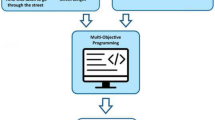Abstract
A web-application for route planning should allow users with special requirements like blind or visually impaired people, and wheelchair users to increase their mobility in urban areas. Especially when visiting an unknown city as a tourist, detailed information is needed. Based on a developed digital map for these special user groups, route planning of barrier-free routes with additional information and pre-trip training will be provided. Moreover, public transport is essential for these user groups. Individual user profiles enable the definition of preferences for every single user which will influence route planning and visualization. The upcoming challenges in data modeling and route planning by using time schedules of public transport and multi-criteria optimization are discussed in this article.
Access this chapter
Tax calculation will be finalised at checkout
Purchases are for personal use only
Preview
Unable to display preview. Download preview PDF.
Similar content being viewed by others
References
Bühler, C., Heck, H., Becker, J.: How to inform people with reduced mobility about public transport. In: Miesenberger, K., Klaus, J., Zagler, W.L., Karshmer, A.I. (eds.) ICCHP 2008. LNCS, vol. 5105, pp. 973–980. Springer, Heidelberg (2008)
Chen, Y.L., Tang, K.: Minimum time paths in a network with mixed time constraints. Comput. Oper. Res. 25, 793–805 (1998)
Pressl, B.: Navigationssystem für blinde Personen. VDM Verlag Dr. Müller, Saarbrücken (2008)
Völkel, T., Weber, G.: A New Approach for Pedestrian Navigation for Mobility Impaired Users Based on Multimodal Annotation of Geographical Data. In: Stephanidis, C. (ed.) UAHCI 2007 (Part II). LNCS, vol. 4555, pp. 575–584. Springer, Heidelberg (2007)
Hofmann-Wellenhof, B., Legat, K., Wieser, M.: Navigation – principles of positioning and guidance. Springer, Wien (2003)
Disser, Y., Müller-Hannemann, M., Schnee, M.: Multi-criteria Shortest Path in Time-Dependent Train Networks. In: McGeoch, C.C. (ed.) WEA 2008. LNCS, vol. 5038, pp. 347–361. Springer, Heidelberg (2008)
Wu, Q., Hartley, J.: Accommodating user preferences in the optimization of public transport travel. International Journal of Simulation Systems, Science & Technology 5, 12–25 (2004)
Schulz, F.: Timetable Information and Shortest Paths. PhD thesis, University of Karlsruhe (2005)
Müller-Hannemann, M., Schulz, F., Wagner, D., Zaroliagis, C.: Timetable Information: Models and Algorithms. In: Geraets, F., Kroon, L.G., Schoebel, A., Wagner, D., Zaroliagis, C.D. (eds.) Railway Optimization 2004. LNCS, vol. 4359, pp. 67–90. Springer, Heidelberg (2007)
Hallam, C., Harrison, K.J., Ward, J.A.: A multiobjective optimal path algorithm. Digital Signal Processing 11, 133–143 (2001)
Mayerhofer, B., Pressl, B., Wieser, M.: ODILIA - A Mobility Concept for the Visually Impaired. In: Miesenberger, K., Klaus, J., Zagler, W.L., Karshmer, A.I. (eds.) ICCHP 2008. LNCS, vol. 5105, pp. 1109–1116. Springer, Heidelberg (2008)
W3C. Web content accessibility guidelines 1.0 (1999)
Hardt, A., Schrepp, M.: Making Business Software Usable for Handicapped Employees. In: Miesenberger, K., Klaus, J., Zagler, W.L., Karshmer, A.I. (eds.) ICCHP 2008. LNCS, vol. 5105, pp. 502–509. Springer, Heidelberg (2008)
Author information
Authors and Affiliations
Editor information
Editors and Affiliations
Rights and permissions
Copyright information
© 2010 Springer-Verlag Berlin Heidelberg
About this paper
Cite this paper
Pressl, B., Mader, C., Wieser, M. (2010). User-Specific Web-Based Route Planning. In: Miesenberger, K., Klaus, J., Zagler, W., Karshmer, A. (eds) Computers Helping People with Special Needs. ICCHP 2010. Lecture Notes in Computer Science, vol 6179. Springer, Berlin, Heidelberg. https://doi.org/10.1007/978-3-642-14097-6_45
Download citation
DOI: https://doi.org/10.1007/978-3-642-14097-6_45
Publisher Name: Springer, Berlin, Heidelberg
Print ISBN: 978-3-642-14096-9
Online ISBN: 978-3-642-14097-6
eBook Packages: Computer ScienceComputer Science (R0)




